Just over a week to my next birthday, when I make half a century plus 10%, and I was talking with my brother about what I would do to celebrate. I couldn’t give a good answer as I haven’t really decided. It is on a Friday and it is not a day made for celebrating as I am up around 6 the next day to work 5 hours starting at 8.
I was out on my bike later in the day and it got me thinking whether I had received many better birthday presents. It is not an extensively researched list, I have forgotten many birthdays and their presents so apologies to friends and family if you bought me the best ever present and I have forgotten it, but certainly in the recent past I cannot think of any that are better than a bike in the constant positive benefit it has brought to my life.

The alley I lived in when I was known as $2, not much but better than 50 cents!
Before I lived in a more solidly Khmer area. To travel around I would hop on the back of a motto* and pay to go where I wanted. My most frequent journey was to work for which I paid $2 and led, I have been told, to my nickname in the alley where I lived ‘bi dollars’ – $2 in Khmer. They might have carried on taking the piss out of me as $2 after I got the bike but I do not know!
4th March 2017, a few days before the actual day, and we went to a bike street in Phnom Penh to look for a bike. One street with shop after shop selling bikes and little else.
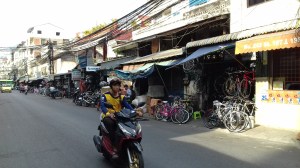
Street 107 – where to buy a bike in Phnom Penh
I was looking for a street bike, nothing fancy, preferably white with black trim. One was found but the saddle was too low so an extension was added and the same happened with the handle-bars. A quick test ride and the bike was bought and given to me. We went off and cycled to a bar I had recently been to, to welcome back a friend just returned to Phnom Penh, but we would not normally have gone to together as it would have involved planning, getting a tuk-tuk, etc. Having a bike had already improved my life.
Subsequently I learned the joys of cycling in Phnom Penh, to work or for pleasure. When

New bikes parked at Show Box
I talk about it people ask me about the danger of the traffic in Phnom Penh. Yet, for me, it is the safest city I have cycled in. In the UK, France or Australia the traffic is all so orderly and managed that it goes so fast. As a cyclist it can be quite frightening. However the traffic here is chaos. A vehicle or motto can come at you in any direction at any time. As a result the cars, coaches and lorries drive slowly. All the road users are looking out for everyone else. It is chaos, but it is an elegant chaos.
So I started to save my $2 a journey to work – $24 a week, nearly $100 a month! I have also improved my fitness. Phnom Penh is a city you cannot walk around easily, with

The bike as it is now, with added rear light and mudguards – for the rainy season.
relatively cheap and easy to get mottos and tuk-tuks, the lack of pavements, and the temperature hardly anyone walks anywhere. As an example, the summer before coming here I was physically active for more than an hour and a half a day whereas, even with the walking around at work, it was less than 30 minutes a day. Together with the cheap beer it resulted in my weight going from 85ish kilos to almost 100, despite my attempts at swimming. I am active for more than 70 minutes most days now and my weight, despite the cheap beer, is now reducing again.
On a bike you can see things you do not see in a tuk-tuk, especially the new Indian ones or even on the back of a motto. I have witnessed more about daily life in Phnom Penh from my saddle than I would have otherwise.
Not everything is perfect. In the rainy season I would get a mud trail up my back and had

New brake blocks being fitted.
to fit mudguards which detracted from the clean, lean, lines of the machine. Too many people I know have had their bikes stolen so it is necessary to lock it up and keep it visible. Some places where people park their mottos, which have security watching over them, will not accept bikes as they are not thought to be serious. I have always lived on the 2nd floor so it is either a case of paying a few dollars a week for parking or carrying it upstairs, however, as a friend commented, it is useful upper-body exercise too! Finally, the way I ride puts pressure on the brakes and handle-bars. The later had recently become lose but a nearby garage tightened them up for free. More worryingly I seem to get through a set of brake-blocks a month. I accelerate fast from junctions, to get through them quickly before I can get hit by something coming from another direction, which also calls for sharp breaking. This wears the brakes. And this has been costing me around $6 a month for new brakes. This week they had got bad again and I had to use my feet to stop a couple of times so, on my day off, back to bike street for new

The new, expensive brake blocks!
brakes. These cost $10 and I was assured they were better than the cheap brakes I had before.
So, despite the caveats mentioned in the last paragraph, I still value the bike for the freedom it has bought me to go where I want, when I want. My main regret is that I have not used it to visit places further away in Phnom Penh. It has extended the area of places I regularly go, but I have not managed to do things like join Phnom Penh Easy Riders for a visit out of the city, or the Hash on one of their rides. So I’m richer, fitter and have witnessed more of life in Phnom Penh than I otherwise would have. All from the saddle of ‘My White Bicycle.’
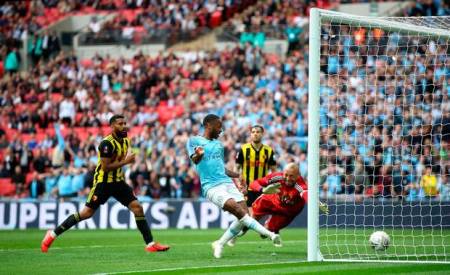 Sterling scores the 6th goal of the game.
Sterling scores the 6th goal of the game. 




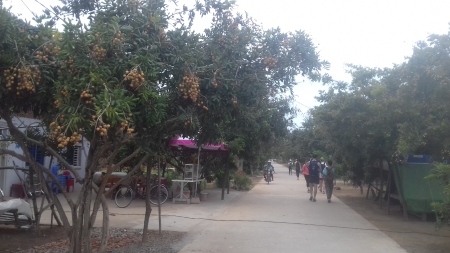



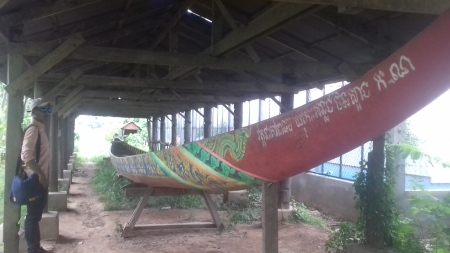


 Time for the bikes to be put on the bus. It’s a thing in Cambodia. Get out of the city, avoid the traffic and arrive fresh, at lunchtime to visit the planned temple. We had been promised the journey would be three hours and would arrive, at the latest, in Kampong Thom by midday.
Time for the bikes to be put on the bus. It’s a thing in Cambodia. Get out of the city, avoid the traffic and arrive fresh, at lunchtime to visit the planned temple. We had been promised the journey would be three hours and would arrive, at the latest, in Kampong Thom by midday.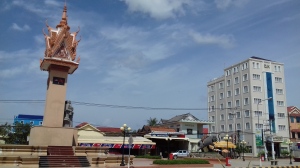
 swimming I had to lie in the sun or read my book in the shade. Just what the doctor ordered after a term’s work and with days riding ahead.
swimming I had to lie in the sun or read my book in the shade. Just what the doctor ordered after a term’s work and with days riding ahead.

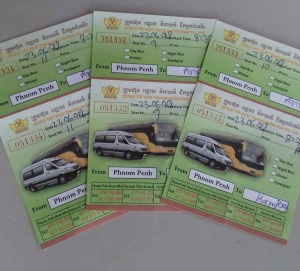 road-trip starts here. Or, well when we collect the bikes tomorrow, or maybe when work finishes tomorrow evening or perhaps, even on leaving Phnom Penh on Saturday.
road-trip starts here. Or, well when we collect the bikes tomorrow, or maybe when work finishes tomorrow evening or perhaps, even on leaving Phnom Penh on Saturday.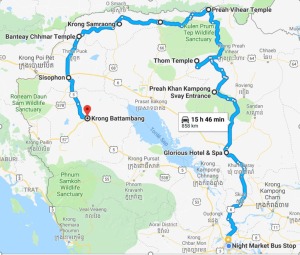 The next day is temple day. It is a ride to
The next day is temple day. It is a ride to 
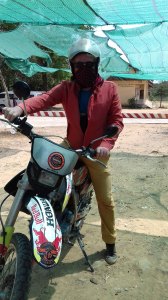

 canning factory for Cambodia Beer in the same area. The beer have now just become the Cambodia beer sponsor for my football team so I was pleased to see a poster featuring the team outside the canning factory.
canning factory for Cambodia Beer in the same area. The beer have now just become the Cambodia beer sponsor for my football team so I was pleased to see a poster featuring the team outside the canning factory.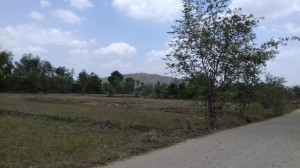
 I was from and where I was going and, in response, he told me I was only 3 km further to go on the road before the turning for Phnom Chisor. Around 3 km further and there was a big sign which, from what I knew looking a the site on the internet before, I could see indicated that the turning led to it. I turned down the dirt road catching the occasional glimpse, before I saw the view pictured above. It was not long after that before I arrived, parked the motorbike and paid for it. Despite having a litre of water before leaving and stopping to have another, I’d had bare arms and face on the journey down so would have lost a lot of water. I stopped to buy some from a woman who charged me $1. It is 500 riel, 12 1/2 cents in Phnom Penh and I said so but the only way I would get the water was to pay it so I did. I walked on to find the sign above which told me there were 412 steps to the top. Great! But, good for my health, lol.
I was from and where I was going and, in response, he told me I was only 3 km further to go on the road before the turning for Phnom Chisor. Around 3 km further and there was a big sign which, from what I knew looking a the site on the internet before, I could see indicated that the turning led to it. I turned down the dirt road catching the occasional glimpse, before I saw the view pictured above. It was not long after that before I arrived, parked the motorbike and paid for it. Despite having a litre of water before leaving and stopping to have another, I’d had bare arms and face on the journey down so would have lost a lot of water. I stopped to buy some from a woman who charged me $1. It is 500 riel, 12 1/2 cents in Phnom Penh and I said so but the only way I would get the water was to pay it so I did. I walked on to find the sign above which told me there were 412 steps to the top. Great! But, good for my health, lol.


















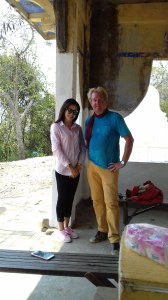 was asked for a photo by a school-girl. I wondered at the wisdom of it but thought it okay as her teacher and colleagues were there. I also thought about having my picture taken as the only Barang at the temple, but thought what the hell. I got one in return. Through my poor Khmer and their better English I found out they were a group of students from a school in Phnom Penh and the teacher with them was their Khmer teacher. There were English teachers with them but they were elsewhere in the temple. It would have been nice to talk to them, professional to professional. I bought a water for 2,000 riel and after a rest made my way down again.
was asked for a photo by a school-girl. I wondered at the wisdom of it but thought it okay as her teacher and colleagues were there. I also thought about having my picture taken as the only Barang at the temple, but thought what the hell. I got one in return. Through my poor Khmer and their better English I found out they were a group of students from a school in Phnom Penh and the teacher with them was their Khmer teacher. There were English teachers with them but they were elsewhere in the temple. It would have been nice to talk to them, professional to professional. I bought a water for 2,000 riel and after a rest made my way down again.

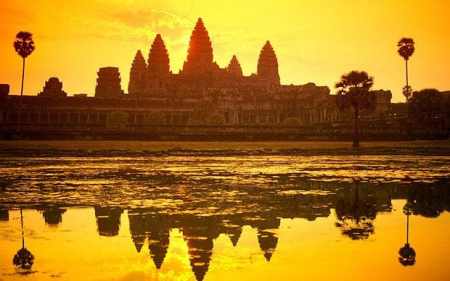 credit: the telegraph
credit: the telegraph 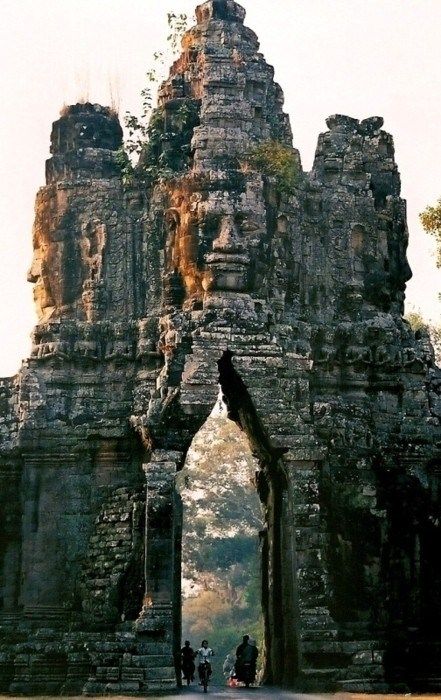 credit: Pinterest
credit: Pinterest  credit: asienreisender
credit: asienreisender 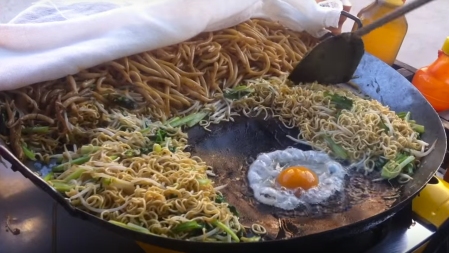 credit: goankhmerunited
credit: goankhmerunited  credit: adventureinyou
credit: adventureinyou 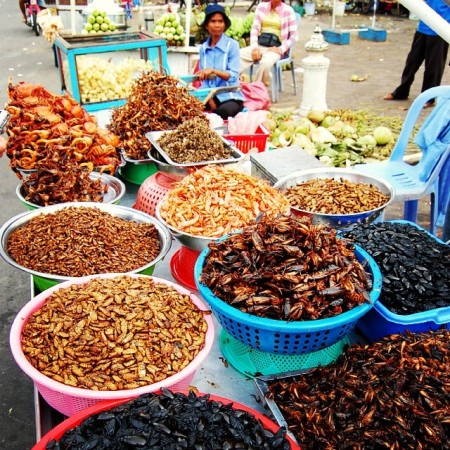 credit: urbanadventures
credit: urbanadventures 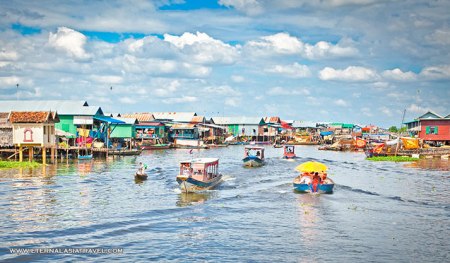 credit: eternalasiatravel
credit: eternalasiatravel  credit: mekongtourism
credit: mekongtourism